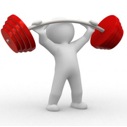Sidney Stohs, Ph.D. Senior
Vice President of Research and Development, AdvoCare; former
Dean, School of Pharmacy, Creighton University; professor of
pharmacology and toxicology; holder of the Gilbert F. Taffe Jr.
Endowed Chair in Research; fellow, American College of Nutrition;
fellow, Academy of Toxicological Sciences; author, more than 300
research and educational publications; doctorate in biochemistry
and microbiology, University of Wisconsin.
Gluten Intolerance and Celiac Disease
Celiac disease is an autoimmune disorder that has immunologic,
environmental and genetic components. It is one of the most common
immune-mediated disorders characterized by a response to ingested wheat
gluten and related proteins from rye and barley, leading to inflammation
and damage to the intestinal lining (mucosa). The incidence of celiac
disease in the United States is believed to be about 1% of the
population. Characteristic symptoms include diarrhea, chronic
malabsorption, anemia, occasional constipation, abdominal cramps, gas
and bloating. However, not all individuals suffer from abdominal
distress. Some individuals may experience fatigue, headache,
neurological problems, distress, infertility, weakness and skin
conditions such as dermatitis herpetiformis.
The eight food allergens that account for 90% of known food
allergies include milk, eggs, fish, shellfish, tree nuts, peanuts, wheat
(gluten) and soy beans. Gluten intolerance disorders bear the names
celiac disease, sprue, and gluten enteropathy. The incidence of gluten
intolerance is much greater than 1% in conjunction with diabetes,
neurological disorders, skin diseases, digestive disorders including
irritable bowel syndrome (IBS), joint disorders, infertility, chronic
fatigue syndrome and fibromyalgia. Individuals with gluten intolerance
have required an average of 9 years from the onset of symptoms until a
firm diagnosis was obtained. This has been due in part to the lack of
sensitive and rapid immunologic assays for gluten proteins. Recently
developed immunologic assays are becoming more available, and health
care providers are slowly learning to recognize that gluten intolerance
is widespread and much more common than had been previously recognized. A
recent study suggests that over ¼th of the population in the United
States is gluten sensitive based on immunologic assays, while
approximately 1% may have progressed to a serious symptomatic disease
state.
The treatment for gluten intolerance–related conditions is a
gluten-free diet, and if one wishes to remain symptom free, the gluten
free diet must be maintained for life. Gluten is a mixture of several
proteins found primarily in wheat, barley and rye. Oats contain a
related protein that the vast majority of individuals with gluten
sensitivity can tolerate. However, oats are frequently milled using the
same equipment for wheat, barley and rye, and may therefore be
contaminated with these grains. As a consequence, it may be prudent to
avoid oat-based products.
One should avoid any ingredient derived from wheat, barley and rye
including such ingredients as malted barley, hydrolyzed proteins from
these grains, filler flour, graham flour, barley extract, hydrolyzed
wheat starch, wheat bran and germ, wheat protein, wheat-derived amino
acids, oat extract, oat flour and vegetable starch. Products such as soy
and Brewers yeast should also be avoided because they may contain
extracts from wheat, barley or rye.
Unfortunately, gluten is used in the manufacture of virtually all
packaged, canned and boxed processed foods to improve palatability and
texture. Gluten is in essence a glue that may hold products together.
Common processed foods that contain hidden gluten include breads,
cereals, cookies and cakes, flavored potato chips, frozen dinners,
pastas, pies, sauces and gravies, some salad dressings, soy sauce,
teriyaki sauce, dried and canned soups, barbecue sauce, breaded meats
(fish, chicken, shrimp, steak, etc.), crackers, and cous cous.
Frequently, symptoms can be relieved in gluten-sensitive individuals
by going gluten-free for two weeks. However, in severe cases, a longer
period of time may be required. Some individuals may have a concurrent
sensitivity to other proteins in addition to gluten, as for example,
casein and whey found in milk-derived products, tomatoes, white
potatoes, eggplant, peppers, tobacco, peanuts and soy.
Flour substitutes that can be used in lieu of gluten-containing
flours include corn flour and corn meal, almond flour and almond meal,
buckwheat (soba) flour and groats, flax seed flour, millet, fava bean
flour, besan (chickpea or garbanzo bean) flour, potato flour, quinoa,
rice and rice flour, sorghum (milo), soy flour, tapioca flour, teff and
amaranth flour.
AdvoCare products are not produced at certified gluten-free
manufacturing facilities. Therefore, we do not certify any AdvoCare
products as gluten-free. Individuals who have celiac disease and are
gluten-intolerant are advised to consult their healthcare providers
regarding AdvoCare products that may be suitable for their use.
















